Sea snakes are members of the Elapidae family in the Indian and Pacific Oceans. Also, sea snakes are usually found in saltwater, although some species prefer freshwater. Overall, there are about 69 species of sea snakes worldwide, and these 69 species can be grouped into seven unique genera. Want to know more about sea snakes? Stick around to find the most venomous sea snake ever to exist and what makes these species different from their land-based brethren.
Sea Snakes
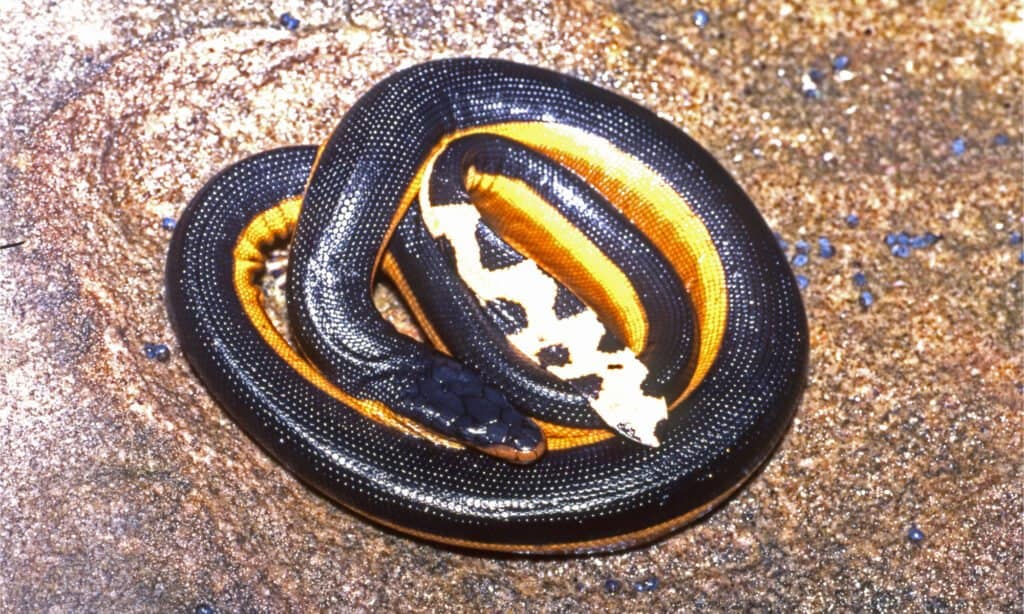
Yellow-bellied sea snakes have paddle-shaped tails that they use as a rudder.
©Ken Griffiths/Shutterstock.com
Snakes are among the most widespread animals in the world, with over 3000 species and counting. They may be found everywhere on Earth except Antarctica. Over time, snakes have changed from terrestrial animals to aquatic inhabitants, becoming sea snakes. This does not imply that a snake is inherently a sea snake just because it can survive in water. Sea snakes have fully adapted to aquatic life and can move on land, except for sea kraits which have even limited land movement.
To be classified as a sea snake, a snake must be a part of the Hydrophiinae or Laticaudinae subfamilies. It is easy to get enthralled by sea snakes because of how unique they look. These creatures are undoubtedly gorgeous, but they are also dangerous. All sea snakes are venomous except those that fall under the Emydocephalus. Here’s what you should know about them;
How To Identify Sea Snakes

Oxyuranus microlepidotus, also known as Inland taipan, is one of the world’s most venomous and deadly snakes.
©Ken Griffiths/Shutterstock.com
It is impossible to determine the DNA of every snake you come across in the ocean to confirm if they are sea snakes. However, one sure way of telling them apart from their land-based counterparts is by their tails. Most sea snakes are entirely aquatic and have made numerous adjustments to life in the water, most notably by growing a paddle-like tail to enhance their swimming prowess.
Many sea snakes’ bodies have compressed due to spending all of their time in the water. As a result, the size of their ventral scales has decreased. Additionally, they have enlarged lungs that span the entire length of their bodies and can remain submerged in water for up to eight hours, sometimes longer, because they can breathe through their skin.
It is easy to mistake sea snakes for eels. Unlike sea snakes, eels have a ridge or fin that spans the length of their bodies. Looking for a dorsal fin is the most reliable approach to differentiate between the two. Sea snakes also closely resemble Asian cobras and Australian terrestrial elapids, and there is a lot of debate as to whether or not sea snakes evolved from these two snake types.
Are Sea Snakes Dangerous?
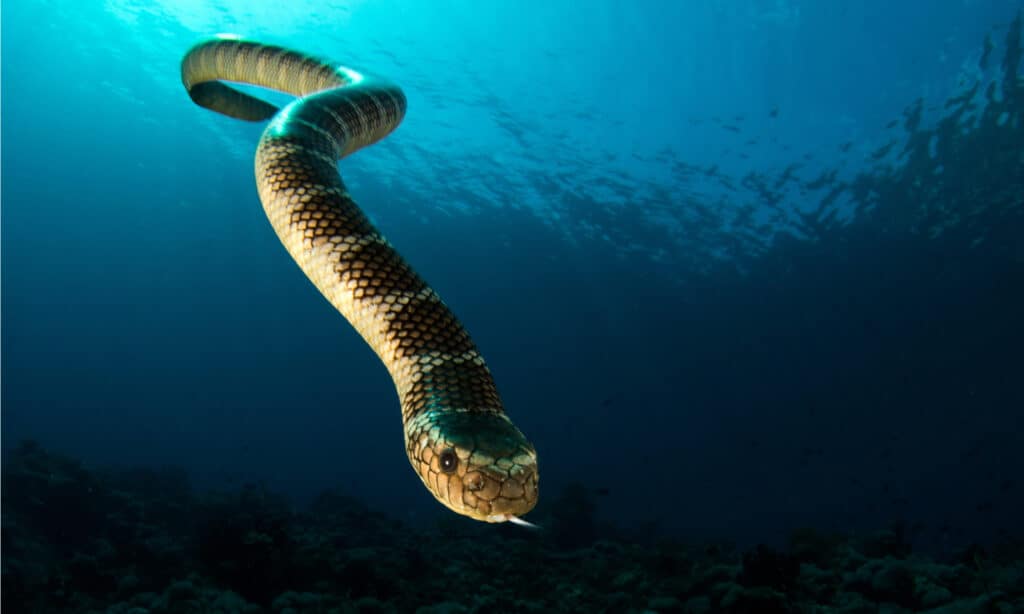
Most sea snakes are venomous.
©Tomas Kotouc/Shutterstock.com
Except for the genus Emydocephalus, most sea snakes are venomous, just like some of their land-based counterparts. However, even though most are extremely venomous, they do not inject their venom when they bite. Envenomation bites are typically quick and painless, and because the venom is slow acting, you might not feel anything for up to 30 minutes after the bite. This is in contrast to regular bites you would receive from a sea snake and feel the pain immediately. Generalized soreness, stiffness, and muscle discomfort are initial signs of a snake bite. Then, the paralysis of the voluntary muscles happens.
What Is The Most Venomous Sea Snake In The World?

The Dubois’s sea snake is the most venomous sea snake in the world.
©IHX/Shutterstock.com
Initially, the most venomous sea snake in the world was the Hydrophis belcheri, also known as the Belcher’s sea snake or faint-banded sea snake. Even though this snake is highly venomous, there aren’t many instances of attacks from it because it doesn’t bite people frequently, and even when it does, it only injects a small amount of venom. Remember that the faint-banded snake, like other sea snakes, is not aggressive and will not attack unless it feels threatened. Additionally, because of their small size and limited area for grip, they have a more difficult time biting people. However, it is estimated that during the first 30 minutes of a bite, its venom can be fatal to people, with a toxicity rating of 0.24mg/kg.
Although the faint-banded sea snake has been identified as the most venomous worldwide, recent studies have disproved this claim. The title now belongs to a different sea snake, the Dubois’s sea snake, otherwise known as the Aipysurus duboisii or the reef shallows sea snake. The snake’s venom is a toxic neurotoxin that can result in systemic symptoms such as extreme exhaustion, muscular weakness, respiratory failure, and complete paralysis. These snakes have an LD50 rating of 0.044 mg/kg, making them the most venomous sea snake and the fourth most venomous snake in the world. Within a few hours of the attack, Dubois’ sea snake bite symptoms and indicators could become obvious.
What Makes Sea Snakes Different From Land-Based Snakes?
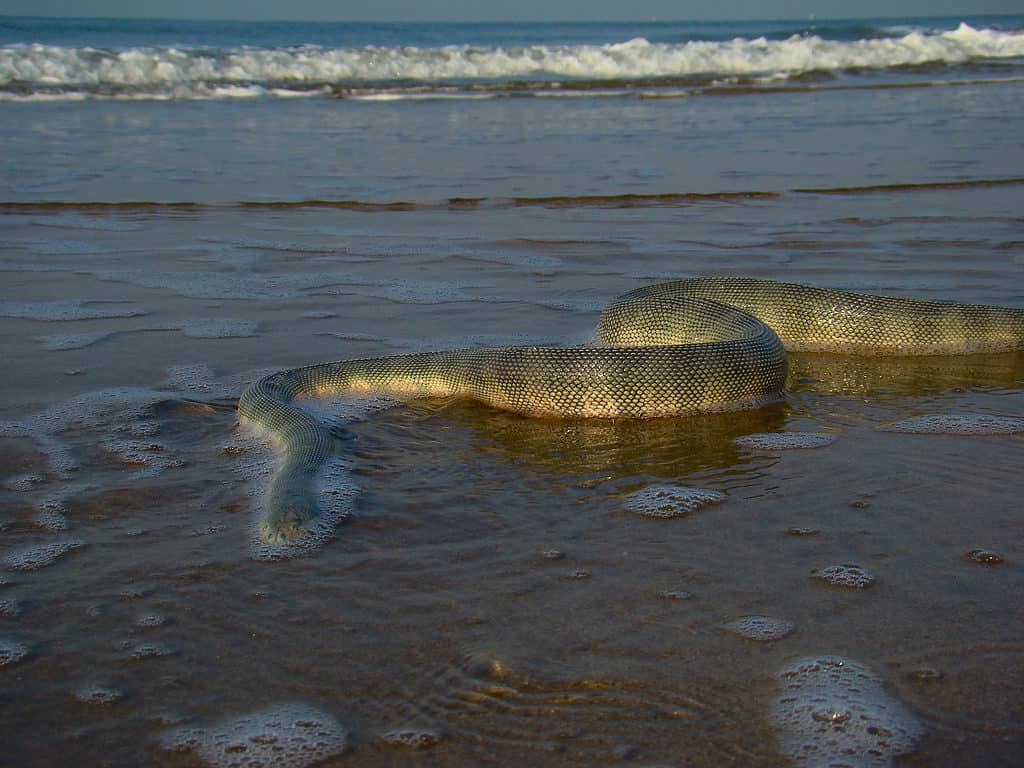
Venomous sea snakes have the ability to breathe through their skin which helps them swim better.
©IHX/Shutterstock.com
Minus the obvious difference that not all sea snakes can function on land and not all land snakes can function in water, one of the primary differences between sea snakes and land-based snakes is the shape of their bodies. Sea snakes have flatter bodies that have evolved to help them glide better while at sea. Land-based snakes, on the other hand, have thicker bodies. Sea snakes also have paddle-like tails and the ability to breathe through their skin which helps them swim better and not struggle for air.
Although sea snakes spend a lot of time in saltwater, they still need fresh water to drink, or they would die of dehydration. To get fresh water, they either wait for rain, swim to the surface or sometimes land to drink water. However, it is impossible for sea snakes not to ingest salt water. Their bodies have evolved, and they have a salt gland that expels the excess salt from the salty water they ingest. Land-based snakes do not have this ability, and as such, they cannot survive in saltwater.
Also, land-based snakes are more aggressive than sea snakes. Although some would rather avoid attacking humans, most do not hesitate to do so, whether or not they feel threatened. Sea snakes are not aggressive until when attacked or threatened, and even then, they would rather swim away from humans than get into confrontations.
Sea snakes are also more venomous than their land-based counterparts, some even more venomous than a king cobra. The reason for this is that while land-based snakes can wait for the venom from their bite to kick in and kill their prey, sea snakes do not have such a luxury of time because their prey could easily escape into the deeper parts of the ocean. As such, they had to evolve to develop more potent venom.
Other Dangerous Animals Found In The Water
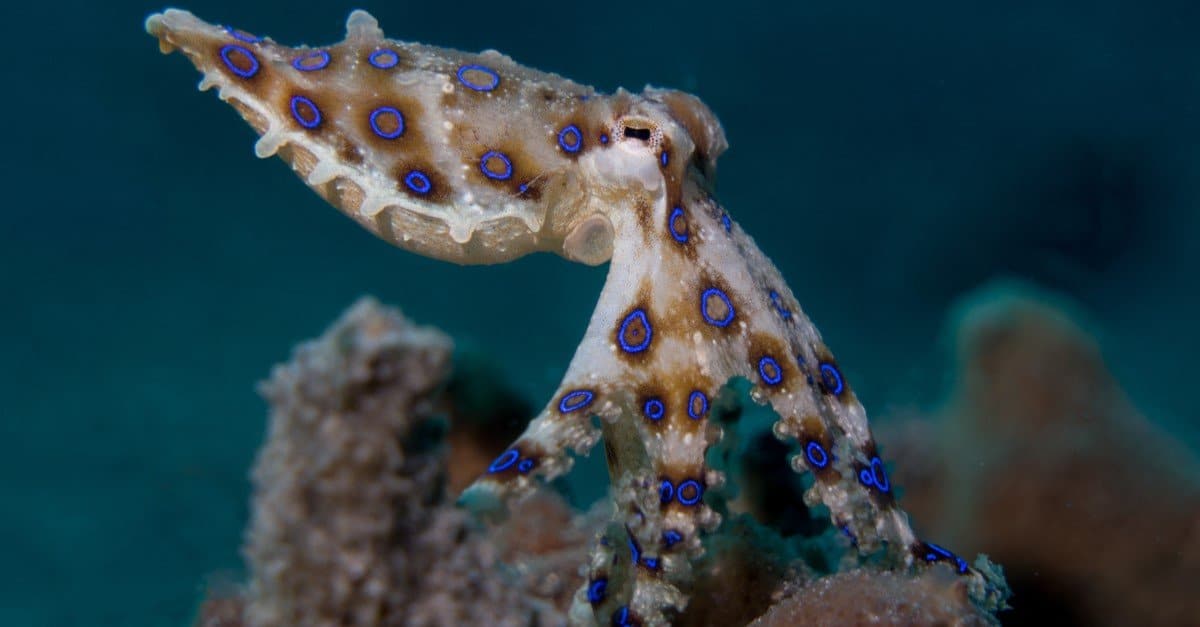
A Blue-ring octopus holds two types of venom and are lethal enough to kill 26 adults.
©Sascha Janson/Shutterstock.com
The world’s ocean has no shortage of beautiful and dangerous creatures and many of them are some of the smallest animals to be found. The blue-ringed octopus, at just 1.5 to 2.36 inches long, with arms reaching 2.75 to 3.93 inches, these octopuses may be little but they pack a venomous punch. Found in the Pacific Ocean, mostly in Japan and Australia, this cephalopod uses its beautiful colors as a warning to others to keep away. Should the warning not be heeded, a neurotoxin will be released through its salivary glands, a toxic venom that is 1,000 times more potent than cyanide and can kill 26 human adults in mere minutes. There is no antivenom available at the present time.
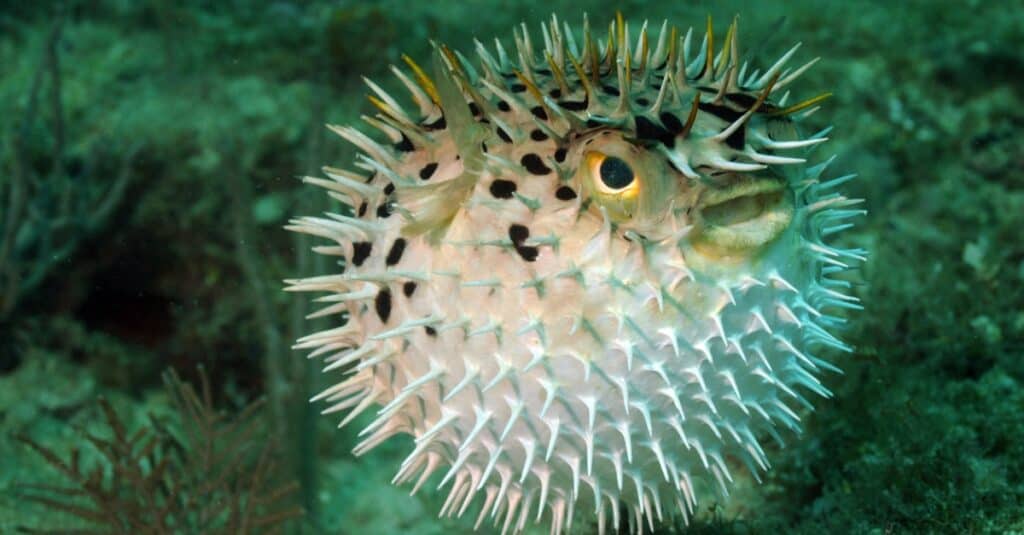
The stomach of a
pufferfish
can inflate up to three times its normal size.
©iStock.com/FtLaudGirl
The puffer fish is a species of poisonous fish that contains the neurotoxin tetrodotoxin in their internal skin or organs, making them taste offensive and can often cause death. Some species are covered in spikes, which makes them more inedible to predators but they all can inflate themselves when in danger. The puffer fish contains high levels of toxin, almost 1,200 times more potent than cyanide, and can kill 30 human adults. As dangerous as this fish is, it is still prepared as a delicacy in Japan, known as fugu, and may only be served by licensed fugu chefs in order to avoid any mistakes in preparation.
The photo featured at the top of this post is © Naganath R/Shutterstock.com
Discover the "Monster" Snake 5X Bigger than an Anaconda
Every day A-Z Animals sends out some of the most incredible facts in the world from our free newsletter. Want to discover the 10 most beautiful snakes in the world, a "snake island" where you're never more than 3 feet from danger, or a "monster" snake 5X larger than an anaconda? Then sign up right now and you'll start receiving our daily newsletter absolutely free.
Thank you for reading! Have some feedback for us? Contact the AZ Animals editorial team.






